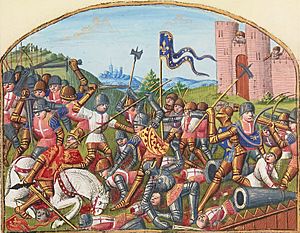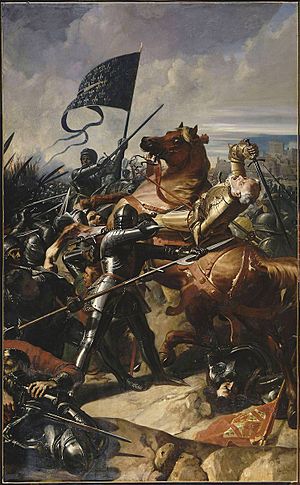Battle of Castillon facts for kids
Quick facts for kids Battle of Castillon |
|||||||
|---|---|---|---|---|---|---|---|
| Part of the Hundred Years' War | |||||||
 The death of John Talbot, Earl of Shrewsbury at the battle of Castillon from Vigilles de Charles VII by Martial d'Auvergne (1484) |
|||||||
|
|||||||
| Belligerents | |||||||
|
|
||||||
| Commanders and leaders | |||||||
John de Foix, Earl of Kendal (POW) |
|||||||
| Strength | |||||||
| 7,000-9,000 1,000 Bretons 300 guns |
5,000–10,000 | ||||||
| Casualties and losses | |||||||
| 100 | 4,000 killed Unknown wounded The rest of the army surrenders the next day |
||||||
The Battle of Castillon was a very important fight between the armies of England and France. It happened on July 17, 1453, in a place called Gascony, near the town of Castillon-sur-Dordogne. This battle was a big win for France. Many historians agree that it marked the end of the long Hundred Years' War.
During the battle, the English leader, John Talbot, 1st Earl of Shrewsbury, thought the French army was running away. So, he quickly attacked their camp without waiting for more of his soldiers. He then refused to stop fighting, even when he saw how strong the French were. This led to many English soldiers being hurt or killed by French artillery (big guns). Castillon was a key battle in Europe because it showed how powerful field artillery could be.
After this battle, England lost almost all its lands in France. This included Gascony, which had been an English possession for about 300 years. The balance of power in Europe changed a lot. England also faced some political problems at home.
Why the Battle Happened
The Hundred Years' War was a very long conflict between England and France. It was mostly about who should be the king of France. The war had been going on for over a hundred years!
In 1451, the French army, led by King Charles VII, captured the city of Bordeaux. This made it seem like the war was finally over. The English only had one place left in France, called Calais. But the people of Bordeaux had been ruled by England for a long time. They felt like English subjects and asked the English king, Henry VI of England, to take their city back.
So, in October 1452, a famous English military leader named John Talbot arrived near Bordeaux with about 3,000 soldiers. Talbot was known for being a brave fighter. He was probably around 66 years old at the time. With help from the people of Bordeaux, Talbot easily took the city back. By the end of the year, England had control of most of western Gascony again. The French knew England was sending an army, but they thought it would go to a different part of France. After this surprise, King Charles VII got his forces ready to fight back.
Getting Ready for the Fight
In early 1453, King Charles VII sent three different French armies to attack the region of Guyenne, all heading towards Bordeaux. Meanwhile, Talbot received more soldiers, including 3,000 men led by his son, John Talbot, 1st Viscount Lisle.
The French army decided to surround Castillon, a town about 40 kilometers (25 miles) east of Bordeaux. This happened on July 8. The town leaders of Castillon asked Talbot for help. Talbot had planned to wait in Bordeaux for even more soldiers, but he changed his mind and set out to help the town.
The French army was led by several commanders. Jean Bureau, who was in charge of the king's artillery, set up their camp very carefully. He wanted to use the French cannons as effectively as possible. They built a strong artillery park (a place for their guns) that was out of reach of Castillon's cannons. This park had a deep trench and a strong earth wall made with tree trunks. It was designed so their guns could fire along the lines of any attackers. The French had up to 300 cannons of different sizes. This camp was protected by a ditch and a fence on three sides, and a steep riverbank on the fourth.
Talbot left Bordeaux on July 16. He rode ahead of most of his army, reaching a town called Libourne by sunset. He only had about 500 knights and 800 mounted archers with him. The next day, this smaller group defeated some French archers near Castillon. Even though he had planned to wait for his main army, Talbot pushed his men forward. He believed the rest of his soldiers would arrive very soon.
The Battle Begins

Talbot was feeling good after the small victory at the priory. He also heard reports that the French were leaving their camp. However, the cloud of dust that the townspeople saw was actually caused by people who followed the army (like merchants and cooks) leaving before the battle.
The English soldiers moved forward but soon ran right into the main French army. The English were outnumbered and in a bad position. But Talbot ordered his men to keep fighting. Historians think he might have felt his honor was at stake because he had already told his men to prepare for battle. Talbot was the only English leader who stayed on his horse during the fight. He also wasn't wearing his full armor. This was because of an agreement he had made with the French when he was released from being a prisoner earlier.
The battle was very typical for that time. The French had strong defenses, and there was a lot of fighting with smaller weapons. In some ways, this battle was like the Battle of Crécy but in reverse. The French cannons destroyed the attacking English soldiers. It was said that each cannon shot could kill six men at once. More of Talbot's soldiers kept arriving, only to face the same deadly cannon fire.
Even with the odds against them, the battle lasted for over an hour. Then, a group of a thousand Breton horsemen, led by Peter II, Duke of Brittany, attacked the English from the side. This caused the English army to break and run away.
The battle ended with the English being completely defeated. Both Talbot and his son were killed. There is some discussion about how Talbot died. It seems his horse was hit by a cannonball, pinning him down. Then, a French archer killed him with an axe.
What Happened Next
The English and Gascon soldiers who hadn't fought in the battle, along with those who survived, went to the castle of Castillon. There were about 5,000 of them, including John de Foix, 1st Earl of Kendal. The day after the battle, Jean Bureau used his cannons to attack the castle. The defenders gave up on July 19 and became prisoners of war.
With Talbot dead and his army destroyed, England's power in Gascony disappeared. The French took Bordeaux back on October 19. At the time, no one knew for sure that the war was over. But looking back, the Battle of Castillon was a major turning point in history. It is seen as the end of the Hundred Years' War. This battle was very important because it showed how powerful field artillery could be.
Later in 1453, Henry VI of England became unwell. This led to a civil war in England called the Wars of the Roses. Some people think that hearing about the defeat at Castillon might have made his health worse. The English Crown lost all its lands in mainland France, except for Calais. Calais was the last English possession in France, and it was lost in 1558. The Channel Islands, which were historically part of France, stayed British. They are still British today, except for a time when Germany occupied them during World War II.

